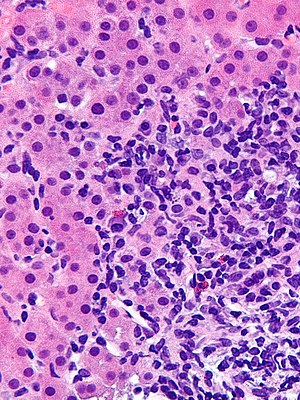Autoimmune hepatitis
| Autoimmune hepatitis | |
|---|---|
 |
|
| Micrograph showing a lymphoplasmacytic interface hepatitis -- the characteristic histomorphologic finding of autoimmune hepatitis. Liver biopsy. H&E stain. | |
| Classification and external resources | |
| Specialty | gastroenterology, hepatology |
| ICD-10 | K75.4 |
| ICD-9-CM | 571.42 |
| DiseasesDB | 1150 |
| MedlinePlus | 000245 |
| eMedicine | med/366 |
| MeSH | D019693 |
Autoimmune hepatitis, formerly called lupoid hepatitis, is a chronic, autoimmune disease of the liver that occurs when the body's immune system attacks causing the liver to be inflamed. Common initial symptoms include fatigue or muscle aches or signs of acute liver inflammation including fever, jaundice, and right upper quadrant abdominal pain. Individuals with autoimmune hepatitis often have no initial symptoms and the disease is detected by abnormal liver function tests.
Anomalous presentation of human leukocyte antigen (HLA) class II on the surface of liver cells, possibly due to genetic predisposition or acute liver infection, causes a cell-mediated immune response against the body's own liver, resulting in autoimmune hepatitis. This abnormal immune response results in inflammation of the liver, which can lead to further symptoms and complications such as fatigue and cirrhosis. The disease may occur in any ethnic group and at any age, but is most often diagnosed in patients between age 40 and 50.
People may present with signs of chronic liver disease (abnormal liver function tests, fatigue, aches) or acute hepatitis (fever, jaundice, right upper quadrant abdominal pain).
"Autoimmune hepatitis usually occurs in women (70%) between the ages of 15 and 40. Although the term "lupoid" hepatitis was originally used to describe this disease, patients with systemic lupus erythematosus do not have an increased incidence of autoimmune hepatitis and the two diseases are distinct entities. Patients usually present with evidence of moderate to severe hepatitis with elevated serum ALT and AST activities in the setting of normal to marginally elevated alkaline phosphatase and gamma-glutamyltranspeptidase activities. The patient will sometimes present with jaundice, fever and right upper quadrant pain and occasionally systemic symptoms such as arthralgias, myalgias, polyserositis and thrombocytopenia. Some patients will present with mild liver dysfunction and have only laboratory abnormalities as their initial presentation. Others will present with severe hepatic dysfunction."
...
Wikipedia
